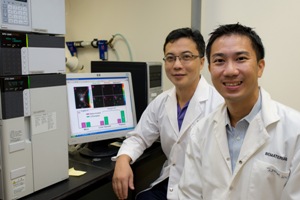Nov 24 2014
Nanyang Technological University (NTU) has invented a unique biomarker with two exceptional functions.
First, it lights up when it detects tumour cells to allow scientists to take a better look. And it can also release anti-cancer drugs at the same time to the specific cells.
 (L-R) NTU Assoc Professors Zhang and Zhang Qichun and Joachim Loo, who invented a 2-in-1 biomarker and drug delivery system
(L-R) NTU Assoc Professors Zhang and Zhang Qichun and Joachim Loo, who invented a 2-in-1 biomarker and drug delivery system
This new biomarker, which has immense potential for drug development, is made from a nanophosphor particle, ten thousand times smaller than a grain of sand.
NTU associate professors Zhang Qichun and Joachim Loo have found a way to make the nanoparticle light up when it is activated by near-infrared light emitted by an imaging device and only if tumour cells release small signalling molecules.
Prof Zhang said the use of near-infrared light, which is invisible to the human eye, is unique as most imaging techniques use ultraviolet light or visible light.
“Near-infrared light can penetrate 3 to 4 cm beyond the skin to deep tissue, much deeper than visible light. It also does not cause any damage to healthy cells, unlike ultraviolet or visible light,” added Prof Zhang, a materials expert.
“Visible light also causes photo bleaching, which is the destruction of the fluorescence dye that reduces the amount of time doctors and scientists have to image a tissue sample. Our new biomarker has effectively eliminated such key limitations which exist in existing biological markers.”
The breakthrough has resulted in two papers published in Small, one of the world’s top scientific journals for material science and nanotechnology.
Prof Loo said their new biomarker can also release anti-cancer drugs by creating a layer of coating loaded with drugs on the outside of the nanoparticle. The drugs are released when the biomarker lights up in response to the near-infrared light.
“This is the first time we are able to do bio-imaging, and potentially target the delivery of drugs at the same time, as proven in small animal tests,” said Prof Loo, a nanotechnology and bioimaging expert. “Our breakthrough will open up new doors in the various fields of nanomedicine, bioimaging and cancer therapeutics.”
The new biomarker also has other advantages. It has twice the contrast of conventional dyes and is able to emit up to three different colours of light. This means that it allows for better differentiation between healthy cells and tumour cells.
Unlike other new biomarkers used for imaging such as quantum dots, the NTU biomarker has also been shown to be non-toxic, staying in the body for up to two days before it is passed out harmlessly.
Moving forward, the team from NTU’s School of Materials Science and Engineering will be looking to load multiple layers of drugs into their biomarker. If successful, doctors will be able to release sequentially two or more drugs through the biomarker. This will benefit cancer patients as there will be fewer side effects due to the small doses administered and also higher efficacy as the biomarker has the ability to accurately target tumour cells.
The project, which took three years, is jointly funded by NTU, the Ministry of Education and the National Research Foundation, Singapore.
The discovery is an important contribution to the University’s research effort in Future Healthcare, which is one of NTU’s Five Peaks of Excellence – interdisciplinary research areas in which the university aims to make a global mark in. The other four peaks include Sustainable Earth, New Media, the East-West knowledge hub and Innovation Asia.
Besides ground-breaking research, NTU has had remarkable success translating its research into innovative applications. Most recently ranked 39th globally by higher education information provider Quacquarelli Symonds, NTU was also ranked No. 1 in the world for industry income and innovation by Times Higher Education.